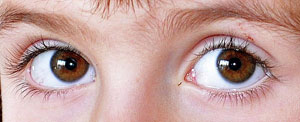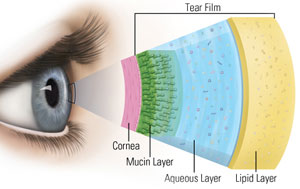** The Humble Eyelid **
 The eyelids are the cleaners of the eye. Similar to the windshield wipers of a car, they push out and wash away dust and other foreign particles from the eye.
The eyelids are the cleaners of the eye. Similar to the windshield wipers of a car, they push out and wash away dust and other foreign particles from the eye.Let us tour the inner workings of this structure. Hopefully we will gain a new appreciation as to what amazing wisdom lies even in this relatively “simple” component of our bodies.
The front part of the eye, (cornea) is a highly organized, structure, clear as glass, made up of groups of cells and proteins precisely arranged in layers. It has no connection to blood vessels. Instead, it receives its oxygen and nourishment from the tear film.
Hence, unlike your windshield wipers, it is very important that the eyelid wipes clean the entire surface of the cornea. If dirt accumulated anywhere, this would cut off parts of the cornea from their vital supply of oxygen and nourishment resulting in pain and infections.
The skin of the eyelid therefore fits perfectly the entire arched surface of the eye so that it can remove even the hard to reach debris at the furthest corners of the eye.
 Small drain holes at the corner of the eyelid drain out all the excess tears, debris, microbes, and allergens, etc. and dump them into the nose.
Small drain holes at the corner of the eyelid drain out all the excess tears, debris, microbes, and allergens, etc. and dump them into the nose.The skin of the eyelid is much thinner than that of the rest of the body. This is convenient for us. If our eyelid skin were thicker, blinking would be cumbersome and the eyelid skin would not fold so compactly above and below when the eye is open. This would create large pockets of skin above and below impairing vision and looking unaesthetic.
The eyelid also blinks rapidly so as not to disrupt our daily activities. Most of us don't even notice the blinking. This rapid movement is essential for activities like reading or following moving objects where uninterrupted sight is needed; or for other activities requiring fast reaction times like bicycling or driving a car.
During blinking little lotion bottles at the rim of the eyelid sprinkle oil into the tear. These bottles are called meibomian glands. The special oily substance, called meibum, lubricates the sliding of the eyelid. Without this lubrication, painful irritation would build up due to friction between the eye and the eyelid when blinking.
The lotion bottles are arranged vertically within the eyelid near the lashes. The force of an eye blink causes just the right amount of oil to trickle out on the lid margin[1].
The special oil lubricates the eyelids and keeps them from sticking together. It also forms a thin film on the tear to protect it from evaporation and to maintain the stability of the tear so it doesn’t collapse due to gravity and eye movements.
There are approximately 50 lotion bottles (meibomian glands) lined up on the upper eyelid and 25 bottles on the lower eyelid. The biochemical composition of the meibum oil is extremely complex. Over 90 different proteins have been identified in human meibomian gland secretion.[2]
Any disease process that alters the components of tears can result in complications.
Patients with meibomian gland dysfunction (MGD), for example, may suffer from a host of eye troubles such as dry eye, irritation, blurring, itching, and infections.
 The tear film between the eye and the eyelid is comprised of three layers: oil, aqueous (wattery), and mucin. These layers are produced by the meibomian glands mentioned above, another gland called the lacrimal glands, and special “goblet” cells (conjunctiva) lining the inside of the eye lid, respectively.
The tear film between the eye and the eyelid is comprised of three layers: oil, aqueous (wattery), and mucin. These layers are produced by the meibomian glands mentioned above, another gland called the lacrimal glands, and special “goblet” cells (conjunctiva) lining the inside of the eye lid, respectively.During the day, the cornea breathes oxygen through the air as it lacks connection to blood vessels like other tissues. When the eye is closed during sleep, and no air is available, the cornea breathes oxygen from capillaries (small veins) in the inside of the eyelid (conjuctiva) which diffuses just the right amount of oxygen into the tear.
Though the eye is closed, the tear film remains intact and is continuously replenished to provide oxygen and nutrients to the cornea[3]. The special meibum oil film mentioned above traps the tears between the oiled edge and the eyeball, and makes the closed lid airtight.
Sensors and balance mechanisms in the eye regulate the precise quantity of tears to produce at all times. Walking into a smoky room, for instance, causes the eyes to water. This shields them from the tiny particles that make up smoke.
The downside is that wattery eyes blurs vision. So normally this does not occur. Too little tear results in dry eyes, which leads to red, irritated and painful eyes. Too little tear also causes excessive friction from the sliding of the eyelid on the eye when blinking resulting in constant pain. Surgery may be needed in some cases to plug the tear drain in hopes of increasing the tear level.
Generally any condition that impairs the functioning of the eyelid results in complications such as chronic eye irritation and infections. For a long list of disorders see here.[4]
As an example, patients suffering from a disease called nocturnal lagophthalmos do not close their eyelids properly during sleep resulting in the cornea being exposed. By morning accumulated aerial dust and dryness needs to be cleaned out and the cornea disinfected. If severe, the disease can bring corneal ulcers leading to blindness.
The condition is not widely understood; in one instance a passenger was removed from a US Airways flight because of it. The flight attendant apparently freaked out after trying to speak with a patient sleeping with his eyes open.[5]
Minor dry eye can also occur at long sittings staring at a computer screen (as happened writing this article). This can be relieved by pausing regularly and closing the eyelids and/or blinking more frequently.
As we can see from experience, the eye possesses a remarkable defense against bacterial infection. Bacteria normally thrive on warm, wet surfaces and the seemingly helpless cornea which lacks proper skin to protect it appears to be an easy target. To make things worse, the cornea lacks a blood supply so the body's normal elaborate immune system cannot come to the rescue.
 But a tailor made immune system works to stop our eyes from becoming infested with hungry bacteria. This immune system is, you guessed it, in the tear film.
But a tailor made immune system works to stop our eyes from becoming infested with hungry bacteria. This immune system is, you guessed it, in the tear film.This is why those suffering from clogged tear ducts, as sometimes happens especially in young children, quickly develop swollen eyes full of pus. The clogged tear ducts can no longer replenish the immune defenses and the eye becomes like a petri dish for bacteria to thrive. Immediate medical care to disinfect the eye and unclog the ducts is urgent.
Among the immune defenses in the tear film:[6]
* Lactoferrin - A sophisticated protein which prevents bacteria from growing and launching a coordinated attack (forming films). It also has antiviral and antifungal activities.
* Lysozyme - powerful enzyme that rips apart bacterial cell walls.
* Beta-Lysin - causes bursting of bacteria resistant to lysozyme by targeting their cell membrane.
* Ceruloplasmin - regulates damage to eye tissue during inflammation.
* Complement System - heavy artillery. when stimulated by one of several triggers, it initiates an amplifying cascade of reactions which activates a massive cell-killing membrane attack complex[7]. Don’t mess with this one.
* Immunoglobulins - various sorts of antibodies which tag foreign bodies for destruction. also prevents the adherence of bacteria and clumps them together for sweeping away by the eyelid.
All these mighty detergents are able to tear apart and destroy the sea of hungry micro-organisms floating all around your eye. Yet, they do not do the slightest damage to your eye.
The eyelid also physically shields from foreign objects such as insects or airborne particles. The eyelashes initiate the blink reflex automatically without any thought on your part. This reflex can also be triggered by the slightest touch of the extremely sensitive cornea surface or by visual information of an approaching object. Sophisticated neural network pathways evaluate all this and respond involuntarily. Kids sometimes like to play games with each other to test these blinking reflexes.
Fortunately, we don't need to think about when to blink or when was the last time we blinked. It all happens automatically on its own through a complex nerve system.
Few people realize just how many countless things need to be present and work perfectly in order for our bodies to function normally. As we have seen, even the humble eyelid requires many different things to work together flawlessly.
Those who most recognize their value are people who have an impairment in any one of their intricate components, rendering their lives, one of chronic pain and inconvenience.
By learning about their features, hopefully, we can gain a greater appreciation of them and the other countless features in our body so that we may thank the Almighty for their proper functioning.
>> Next: the Chessmaster
Footnotes
- [1] http://www.aapos.org/terms/conditions/141 return to text
- [2] https://en.wikipedia.org/wiki/Meibomian_gland return to text
- [3] http://biology.stackexchange.com/a/24677/8290 return to text
- [4] https://en.wikipedia.org/wiki/Eyelid#Clinical_significance return to text
- [5] https://en.wikipedia.org/wiki/Lagophthalmos return to text
- [6] http://www.ncbi.nlm.nih.gov/pmc/articles/PMC88956/ return to text
- [7] https://en.wikipedia.org/wiki/Complement_system return to text